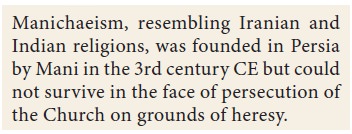History - Zoroastrianism | 9th Social Science : History : Intellectual Awakening and Socio-Political Changes
Chapter: 9th Social Science : History : Intellectual Awakening and Socio-Political Changes
Zoroastrianism
Zoroastrianism
Zoroastrianism is one of the oldest of the revealed
world religions. It remained as the state religion of three great Iranian
empires, which flourished from the 6th century BCE and dominated much of the Near and Middle East. Zoroaster of Persia is the
founder of Zoroastrianism. Zoroaster was pained to find his people worshipping
primitive deities. He revolted against it and proclaimed to the world that
there is one god, Ahura Mazda (the Lord of Light).
The holy book of Zoroastrians is Zend Avesta . It is a collection of
sacred literature of different
epochs, containing religious hymns, invocations, prayers, confessions, laws,
myths and sacred reminiscences. The doctrines and rituals of the Zoroastrians
have much similarity to those of the Vedas.
The language of Avesta bears similarity to that of
the Indo-Aryan. Linguists have established a close relationship between
Indo-Aryan and the languages of West Asia, in particular Iran. The old Iranian
language dates back to the second millennium BCE. Later, it incorporated
languages of Dravidians and those of aboriginals of the Indian sub-continent.
According to the historian Romila Thapar, the old Iranian and Indo-Aryan
speakers originally belonged to a single group and later split up because of
dissentions.
Teachings
Zoroaster taught that the great object of religion,
state or society is the cultivation of morality. The highest religious
conception is purity of thought, word and deed. He asserted that Ahura Mazda
has seven qualities:(1) light; (2) good mind; (3) right; dominion; (5) piety;
(6) well-being; and immortality. Ahura Mazda is omniscient (knows everything),
omnipotent (all powerful) and omnipresent (is everywhere). In Zoroastrianism,
sacrifice and image worship were discarded. Fire was worshipped as a symbol of
the deity and considered the highest form of worship. Charity was made an
essential part of religion, and service to the poor was particularly
emphasised. Human virtues did not mean only prayer, meditation, sacrifices and
rituals. It meant much more, such as fighting evil, making efforts for good and
assisting the activity of Ahura Mazda.
This religion ceased to exist in its place of origin, as in the wake of Muslim conquest of Persia (Iran), many of the Zoroastrian families fled to different countries, including India between the eighth century and tenth century CE. With their dwindling numbers and in the face of coercive measures adopted by the Arabs to push through their new faith, as well as the incidents of destruction of fire temples and killing of priests, Zoroastrianism went into a decline. The Parsis, who came to India from Persia first as merchants and later in the wake of persecution, brought Zoroastrianism with them and they have been practicing it ever since.

Related Topics